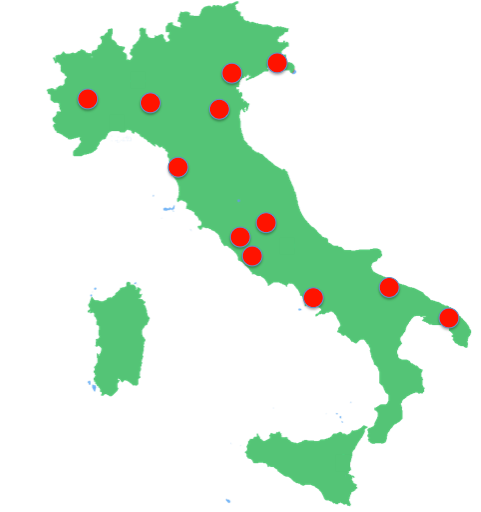Scientific activities of the various Research Units
Bari
- Neutrinos: Global analysis of oscillation data and related constraints on known and unknown mass-mixing parameters; combination with non-oscillation information from single and double beta decay and from precision cosmology; sensitivity to the mass ordering of large-volume atmospheric and reactor neutrino detectors; implications of geoneutrinos observations on Earth models; physics of supernova neutrino flavor transitions; phenomenology of light sterile neutrinos.
- Cosmology and astrophysics: Study of time-of-flight differences of ultra-relativistic particles from distant astrophysical sources; computation of the background of relic gravitational-wave (GW) radiation in pre-big bang inflation models; anisotropic and fractal models of the universe; physics of axions and axion-like particles (ALPs).
Ferrara
- Higgs field: detailed investigations of the stability of the electroweak vacuum in the context of the Standard Model (SM) and applications to cosmic inflation, in the light of recent bounds on the tensor-to-scalar ratio of cosmological perturbations.
- Neutrinos: extensive studies of estimated geoneutrino fluxes and related observations in current and future detectors (including collaboration with the JUNO project), with implications on related global models of the Earth and local models of the crust; investigation of theoretical models for the origin of neutrino masses and mixing.
Lecce
- Astrophysics: Second-order effects in gravitational microlensing: polarization, astrometric microlensing, spin and orbital rotation; analysis of X-ray data of nearby dwarf galaxies; intermediate-mass black holes in the center of globular clusters and dwarf galaxies; use of Planck data to determine the rotation of the disk and halo of nearby galaxies; tidal disruption events in globular clusters; ALPs oscillations in astrophysical magnetic fields.
- Neutrinos: improved bounds on neutrino parameters with new data coming from different sets of (solar, atmospheric, accelerator and reactor) experiments.
LNF
- Dark Matter (DM) model building, especially within grand-unified theories (GUT). Neutrino mass models that might (or not) be able to account for baryon asymmetry of the universe (BAU) via leptogenesis. Mechanisms that could relate the DM to the BAU and to neutrino mass generation.
- Physics of axions, possibly extended to cover ALPs and dark bosons. A first step in this direction has been that of defining more precisely the window where axion experiments should search for signals. A major and challenging issue for all axion models is now being tackled: the need to enforce accidentally a Peccei-Quinn symmetry, protecting it to an extremely high level of accuracy from all sources of explicit breaking.
LNGS
- Neutrinos: Theory and phenomenology of neutrinos from astrophysical sources; solar neutrinos: analysis of the solar composition problem and of future CNO solar neutrino measurement; study of supernova neutrinos in ultra-pure scintillators; expectations for neutrinoless double beta decay, in view of the renormalisation of the couplings of the nucleons in nuclear medium; high energy astrophysical neutrinos: interpretation of neutrino telescopes observations, analysis of (extra)galactic contributions, identification of sources.
- Cosmic rays (CRs): propagation of very high-energy (VHE) CRs in extragalactic environment; nonlinear propagation effects; comparison between different numerical simulations. Particle and nuclear physics studies of big-bang nucleosynthesis (BBN).
Napoli
- Cosmology: sterile neutrinos in the early universe with mass in the eV and keV range; new ab initio calculation for nuclear rates for BBN; bounds on DM lifetime; bounds on low-reheating scenarios from cosmic microwave background (CMB) data.
- Neutrinos effects of inhomogeneities on coherent flavor oscillations; high-energy neutrinos at IceCube as DM decay or annihilation products; neutrino mass-mixing sum rules in SO(10) models.
- Other topics: Supersymmetric (SUSY) GUTs in the LHC epoch; vacuum energy in a Casimir cavity and its interaction with gravity; Gribov problem in non-commutative QED; historical studies, mainly based on unpublished manuscripts by Ettore Majorana.
Padova
- Neutrinos: Global analysis of all short-baseline neutrino data in terms of the 3+1 model with sterile neutrinos; implications for current searches and for planned or future experiments. Combination of oscillation data and relevant cosmological data in the 3+1 model.
- Lepton Physics: Prospects for lepton flavor violation (LFV) in SUSY GUTs in view of low-energy SUSY searches, both direct (at the LHC) and indirect, via flavor-changing neutral currents (FCNC). Interplay between direct DM searches and DM production at the LHC.
Pavia
- Systematic study of photon-ALP conversion in VHE astrophysics for various classes of active galactic nuclei (AGN), with the aim to find observational evidences of this phenomenon, like an anomalously small opacity of the Universe above 100 GeV. Explanation of the VHE spectral anomaly of flaring blazars (unexplained within conventional physics) in terms of photon-ALP conversion. Exploitation of the results obtained by the FP7-funded project "Exploring the X-ray Transient and variable Sky" (EXTraS), aimed at systematically extracting, characterizing and publicly releasing all temporal domain information in serendipitous data collected by the ESA XMM-Newton observatory. A Multi-wavelength study of the gamma-ray pulsars detected by Fermi-LAT.
Pisa
- Stellar evolution: Quantitative evaluation of theoretical and observational uncertainties on the main stellar evolutionary characteristics; uncertainties on stellar mass, radius and ages evaluated through the comparison between theory and observation for single stars and binary systems; dependence of the evolution of the habitable zone of low-mass stars on the stellar characteristics; astrophysical implications of the updated reaction rates (e.g. 2H(d,p)3H, 2H(d,n)3He and proton-proton).
- Cosmic rays: Theoretical modeling of cosmic ray origin and propagation in the Galaxy. Experimental collaborations: Partecipation to MAGIC experiment and Km3Net projects.
Roma I
- Cosmology (with active participation in the Planck mission): Global analyses of the CMB, large scale structure and BBN data in a variety of cosmological models, in particular with nonstandard neutrino properties (extra sterile states, large lepton asymmetry), modified gravity, coupled dark matter (DM) and dark energy (DE), non-flat universe; impact of delensing of CMB anisotropies and forecast for future experiments on constraining light particles (axions). Î-type spectral distortions of the CMB and their implications in constraining inflationary models. As part of the Euclid collaboration, development of an efficient tool to compute the power spectrum of systematics in cosmic shear tomography by propagating, in a realistic way, shear measurement, source properties and survey setup uncertainties.
Torino
- Dark Matter: antibaryon signals from DM; extragalactic diffuse radio background; analysis of ATCA data, with the goal of detecting a non-gravitational signal of particle DM; anisotropies in the gamma-ray sky from different galactic halo models; cross-correlation studies of gamma rays with gravitational tracers (cosmic shear, galaxy surveys, CMB lensing).
- Cosmic rays: detailed analysis of the cosmic electrons and positrons fluxes in terms of astrophysical sources; study of the diffuse gamma ray emission from galactic and extragalactic sources at Fermi-LAT energies.
- Neutrinos: Global analysis of all oscillation and nonoscillation data in terms of models with sterile neutrinos; implications for future experiments and for precision cosmology.
Trieste
- Neutrinos: systematic symmetry-based approach to lepton flavor, aimed at understanding the origin of neutrino masses and mixing; tests of related predictions -including leptonic CP violation phases- via neutrino oscillations and other low-energy experiments; theories of neutrino mass generation and analysis of associated LFV phenomena; studies related to the Dirac or Majorana nature of massive neutrinos; TeV-scale leptogenesis and possible leptonic CP-violating phase effects on the BAU; tests of physics beyond the SM via neutrinos.
- Dark Matter: cross-correlations of cosmological simulations with galactic dynamics observables; tools to test DM particle properties and production mechanisms in the early Universe; phenomenology of DM indirect detection.
- Cosmic rays: environmental effects of CR transport in the Galaxy on the local CR fluxes and on indirect probes, including gamma-ray, neutrino and radio measurements; the Galactic center as a target to test exotic sources, such as DM particle annihilations.
^ Back to Top


